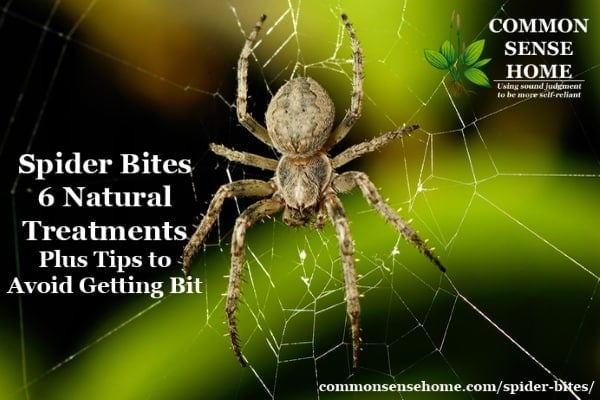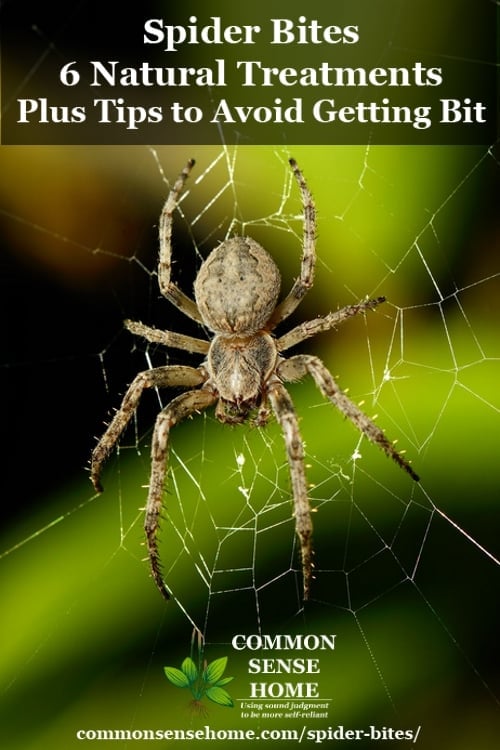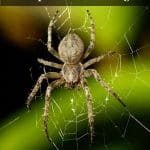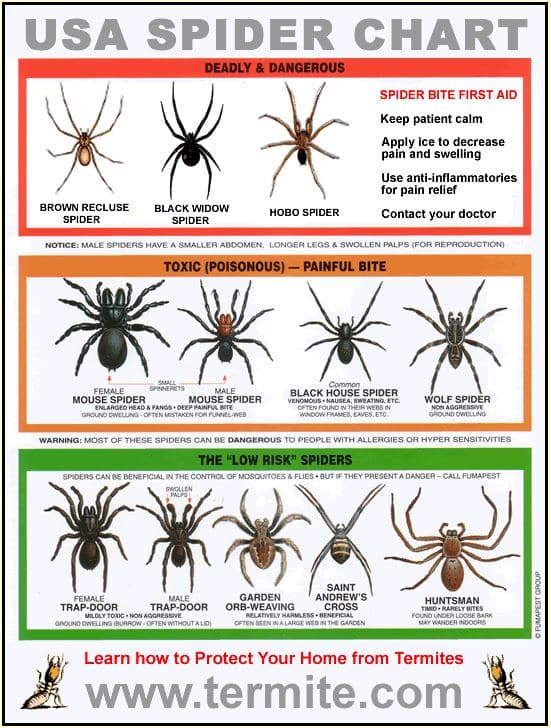Spider Bites – 6 Natural Treatments + Tips to Avoid Getting Bit
This post may contain affiliate links. Read my full disclosure here.
Spider bites are generally uncomfortable but not dangerous, and may be difficult to confirm as spider bites because they look similar to other bug bites and the spider wasn’t caught in the act. A typical non-poisonous spider bite will commonly present as a raised welt – like a big mosquito bite. It itches and may burn or sting a little, but the pain is not incapacitating or severe. Symptoms may last from a few hours to a few days, and can be safely treated at home.

Poisonous spider bites are different, and may require medical attention. About Health notes:
Victims should be concerned when a local reaction continues to get worse for more than 24 hours. Look for redness spreading away from the bite, drainage from the bite, increase in pain, numbness/tingling, or a discoloration around the bite that looks like a halo or bulls-eye.
Victims should seek medical treatment if symptoms appear in parts of the body away from the location of the bite. Black widow spiders have a toxin that affects muscle contraction and nerve function. Severe brown recluse spider bites can also cause some symptoms over the entire body. Look for:
- sweating
- chills
- headache
- body aches
- stomach cramps
- leg cramps
- rapid pulse
- exhaustion
In cases where the victim is feeling extremely tired or weak, call 911.
Black widow bites will commonly present with two red fang marks. Brown recluse bites may initially present like any other bite, but may develop into necrotic arachnidism – the flesh starts to be eaten away by the venom. View brown recluse range.
Some people have more severe reactions to bites or stings. Babies and children may be more affected by bites or stings than adults.
Spider Bite Treatment #1 – Plantain
If you have been stung by a bee or bitten by an insect or even an animal like a snake, plantain poultices can help. Plantain poultices can draw out venom before it has a chance to do damage, can reduce swelling, prevent anaphylactic shock, or delay a severe reaction until medical care can be reached. Read Grandma Called it Medicine Leaf to learn more about plantain.
Spider Bite Treatment #2 – Baking Soda
Baking soda is an effective treatment for spider bites. This alkaline substance can help draw out the venom, which will help reduce pain, itching and inflammation.
Spider Bite Treatment #3 – Activated Charcoal
Activated charcoal has absorption properties that help draw out and remove toxic substances from the body.
Spider Bite Treatment #4 – Comfrey
Comfrey in the form of a poultice for external application is a remarkably effective treatment for wounds that do not heal, such as decubitus ulcers (bedsores), diabetic ulcers, the bites of brown recluse spiders, and the terrible staph infections that affect people living on tropical beaches. (Source)
Learn more about comfrey in Comfrey – Weekly Weeder #40.
Spider Bite Treatment #5 – Meat Tenderizer
Meat tenderizer contains papain, an enzyme that breaks down proteins (like the ones in your T-bone steak). But papain can also break down toxins from bug bites and cut back on itching. Use tenderizer only on mosquito bites, bee stings, and nonpoisonous spider bites. (Source)
Spider Bite Treatment #6 – Herbal Insect Bite/Sting Salve
This soothing salve is great to have on hand for bites and stings of all types.
Would you like to save this?
Ingredients
- 1/2 tsp Calendula Powder
- 1/2 tsp Comfrey Powder
- 1/2 tsp Chamomile Powder
- 1 tsp Plantain Powder
- 1 tsp Bentonite Clay
- Vodka, Witch hazel or Rubbing Alcohol
- 5 drops Tea Tree oil
- 5 drops Lavender Essential Oil
Directions
Mix all dry ingredients and store until needed. When you have a bite or sting, add the essential oils and enough liquid (vodka, alcohol or witch hazel) to make a thick paste. Apply salve to bite and leave on until dry. Reapply as needed.
Tips to Avoid Getting Bit by Spiders Inside Your Home
- When you put things in storage make sure everything goes into sealed plastic bags and include a stick of cinnamon, a bay leaf or a sprig of mint.
- Turn the light on in the closet before reaching your hand inside to grab your clothes
- Always shake out shoes and boots before sliding your foot in
- Turn gloves and hats inside outside out and check for spiders or their eggs
- Wash or shake out any bedding that has been stored
- Thoroughly inspect sleeping bags before and after camping
- Avoid using bed skirts and dust ruffles
- Vacuum curtains weekly to remove spiders, eggs and webbing
- Keep your bed away from the wall
- Keep under your bed clean
- Give all your clothes a good a shake before putting them on even if they have been hanging up
- Don’t leave piles of clothes on the floor
- Don’t keep firewood stored inside
Spider Identification
Although the chance of getting bit by a venomous spider is very rare, it does happen. Brown Recluse spiders are common in South Carolina and I have actually had three friends who suffered greatly from their bite. If you do get bitten by a spider, it is imperative that you are able to identify the type of spider that bit you, ideally you should bring the spider to the doctors or hospital with you for accurate treatment.
Here is a list of typical spiders you will find in North America for you to familiarize yourself with and become knowledgeable at identifying.
Common Household Spiders
- Wolf Spider
- Sac Spider
- Fishing Spiders
- Sow Bud Spiders
- Jumping Spiders
- Parson Spiders
- Crab Spiders
- Cellar Spiders
- Orb Weaver Spiders
- Garden Spiders
- Barn Spiders
Venomous Spiders
- Brown Recluse
- Black Widow
- Hobo Spider
- Mouse Spiders
- Black House Spiders
- Wolf Spiders
Are spider bites a problem in your area? Have any tips for treating bites or avoiding getting bit? We’d love to hear them – just leave a comment below.

You may also find useful:

This post is by Amber Bradshaw of My Homestead Life.
Amber and her family moved from their tiny homestead by the ocean in South Carolina to forty-six acres in the Smoky Mountains in East Tennessee.
While building their off-the-grid homestead, they live like the days of old – cooking without electricity, collecting water from the creek and raising chickens, goats, pigs, turkeys, bees, and guineas. They’ve recently filmed their journey for a TV show on the Discovery Channel and the DIY Network/HGTV called Building Off The Grid: The Smokey Mountain Homestead.



Why remove bed skirt and his bed away from wall? Thanks
Bed skirts and having beds pushed up against the wall allow spiders to travel more freely between the floor/wall and your bed,
I live in New Jersey and we have tons of spiders, especially the brown recluse. Take there name by face-value, they really love dark places especially underneath your bed. The best remedy, I swear to it considering I’m a victim to a bite is one of three things:
1-cinnamon squares put them in a cloth pouch and leave them underneath your bed. If you hate the smell get a bed skirt you’ll never smell it, if you like it enjoy!
2-rub eucalyptus based moisturizer on your skin
3-open your windows and light a citronella candle, if you hate the smell leave the room for up to an hour.
Thanks, Bryan. Stay safe.
I need spider bite my home please I’ll be spiderman ever I want to do.
BenA.
Sorry, Ben, that only works in the comics. Be careful out there.
We recently move to Texas, near Austin. Lived here for the past year and had minor issues with spider bites. But the last 2-3 weeks have been crazy. Is it this time of year….or what?
The bites start as a dot and then get red and are hard under the skin, about 1″ or so in diameter. They itch like crazy and start to ease up after a few days. They are all on legs. Mostly between knees and waist.
Any thoughts on what they would be and how to deal with them?
Our house is a one story and only 15 years old and is made of stone…so it is not an old wooden spider fest.
Could it be in the car? Starting to drive us a little bit crazy.
I’d start by asking long term residents what’s common in your area this time of year. That way you have a better idea of what you are likely facing, how long it’s likely to last, and how the local cope.
For general information, we do have a post on spider repellents and tips to get rid of spiders at https://commonsensehome.com/natural-spider-repellents/.
I was bitten in the back of a leg as a child by a brown recluse whilst sleeping, and didnt notice until later the following night that the poison had eaten away at the back of my leg. My dad used hydrogen peroxide and covered it in gauze and it healed up really quick. It hurt really bad though, and that is where my fear of spiders came from
Thanks for sharing your story, and I’m sorry you were bitten.
Just a little tip I learned from my husband, a master plumber to prevent a Black Widow spider bite. They love to nest in water meter bases. When you go to open your water meter base, DO NOT put your finger inside the hole to pull it up…. especially if you live in one of the southern states (We live in Georgia). The Black Widow is aggressive and won’t hesitate to attack and bite your finger. Instead, use a long screwdriver or other long slim object and allow the sunlight to enter the meter base and DO NOT put your hand inside the base without long thick gloves. If at all possible, use a meter key for turning water on or off. They are inexpensive (about $15-20….depending on where you get it), they allow you to turn the water on and off without having to kneel on the ground and without having to stick your hand into the base. I have been bitten twice by a Black Widow……the last time, just a few days ago. Fortunately, I’m not extremely sensitive to it and I’m only experiencing a lot of itching. But, for some, it could be much worse. They are quick and mean. And, like me, you might not even feel the bite until hours later.
Good tip!
Baking soda has been used commonly for deodorizing, soothing, and cleaning minor wounds, pains, and aches. Hence, it effectively works in the treatment of spider bites. It has anti-itch, anti-inflammatory, and antipruritic properties.
I has been bitten several times by brown recluse throughout my lifetime.I have always lived in the country + remodeled houses.The miracle cure that has worked for me since I was 12 years old and I am 60 years old now is at the first sign of pain and heat in the bite, crack a fresh egg and remove the skin from the inter shell, smooth slimy side down of the egg skin on Andover the bite. Levon 420 minutes without moving until it turns like a sunburn peel. then peel the dried eggshell skin off. Do this several times a day until the poison has been drawn out. Then at night I put Watkins drawing salve on it with a Band-Aid over it to draw out more poison. Like I said this works miracles!
Thanks for sharing.
I would hesitate about remedy #4, comfrey. There is a warning on the Comfrey page that says ” It is not recommended for topical treatment of deep cuts or puncture wounds, as it may cause the wound to close at the top before it heals underneath, increasing the risk of abscess/infection.” For this reason, you must make absolutely sure that there is no more toxin or infection in the spot before you use the comfrey. I love comfrey and have had results that modern medicine wouldn’t believe, but I have also had the pain of having to cut a wound open because of the infection/pus still in there.
Thanks for the note, Terry, and you are absolutely right. I’ll get that clarified tomorrow. (Heading out to work on the trees today.)